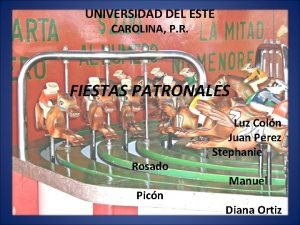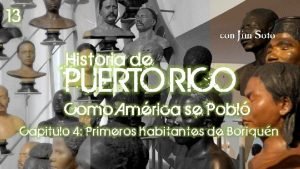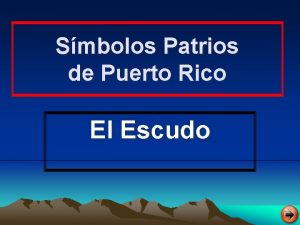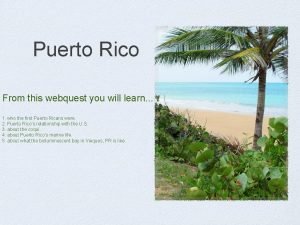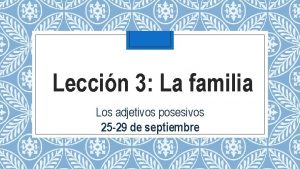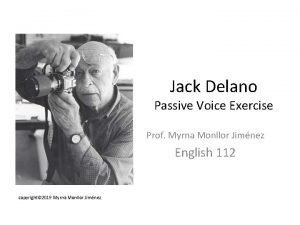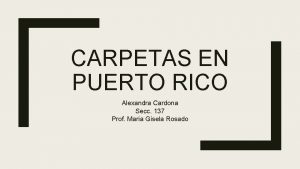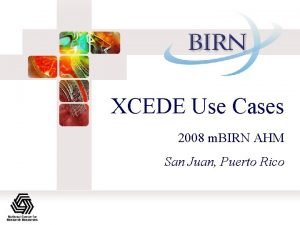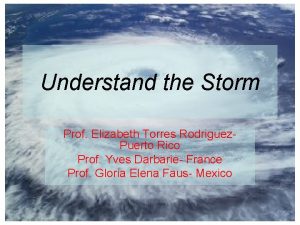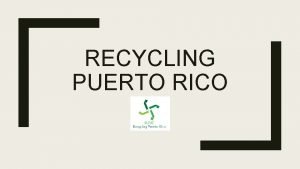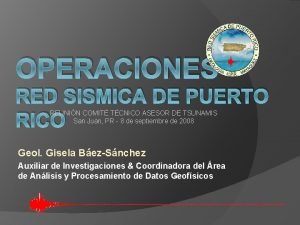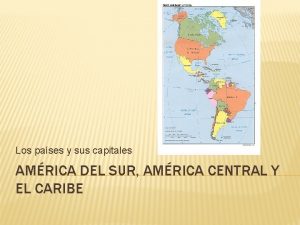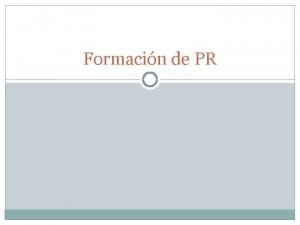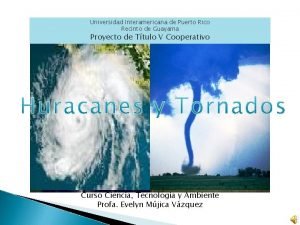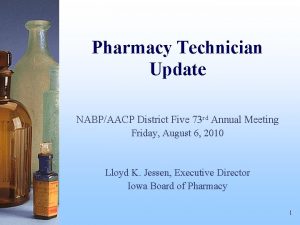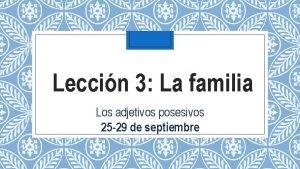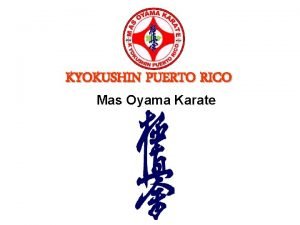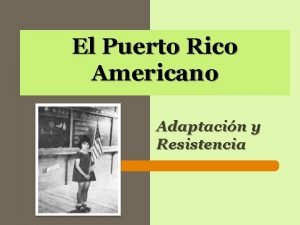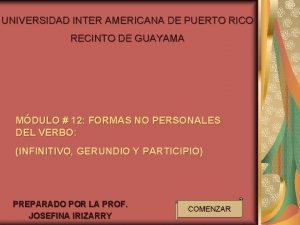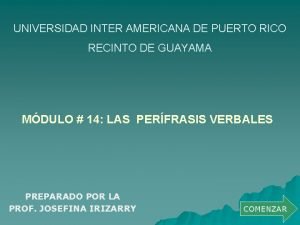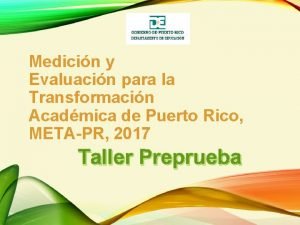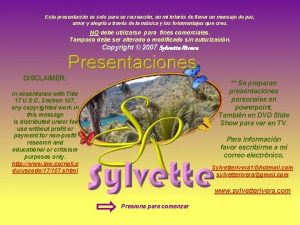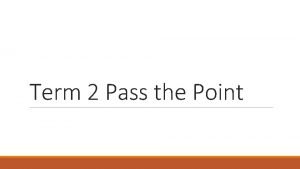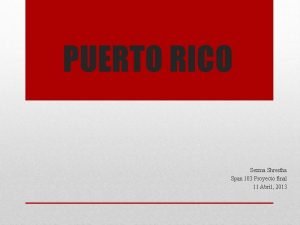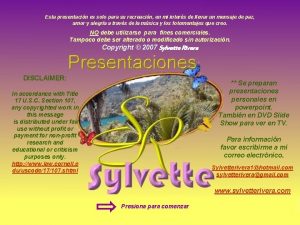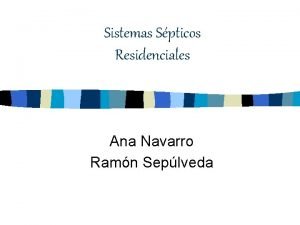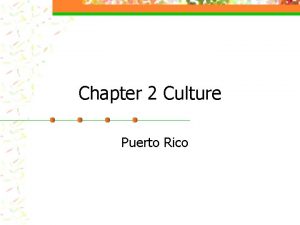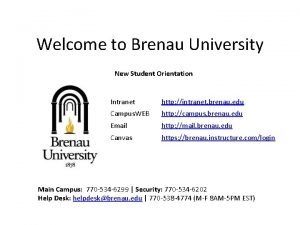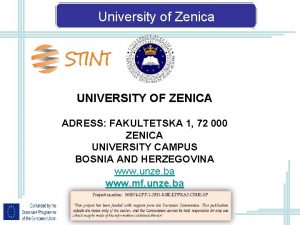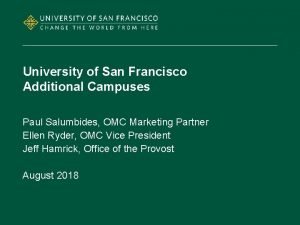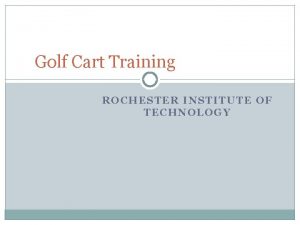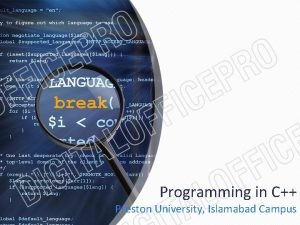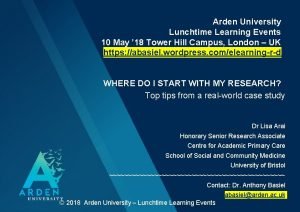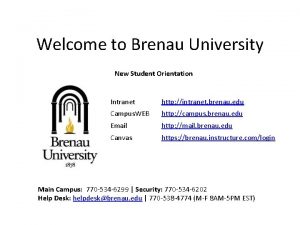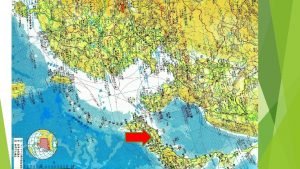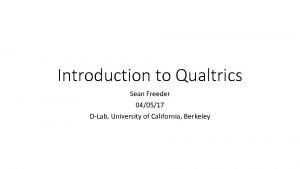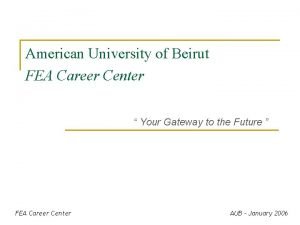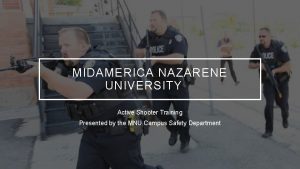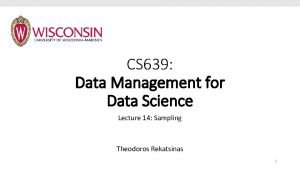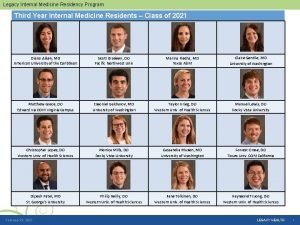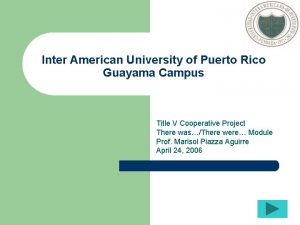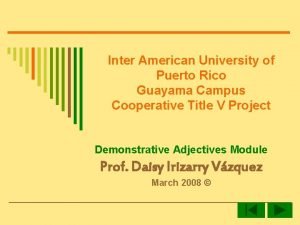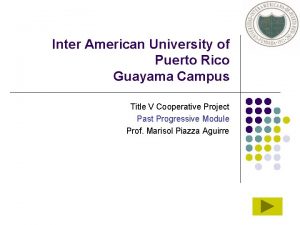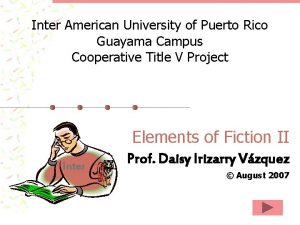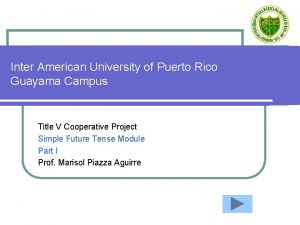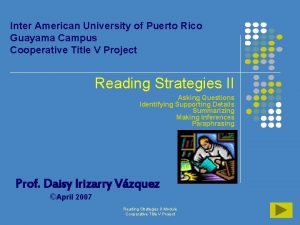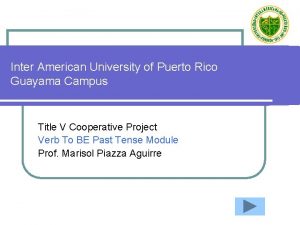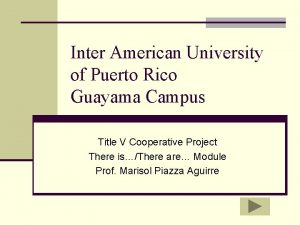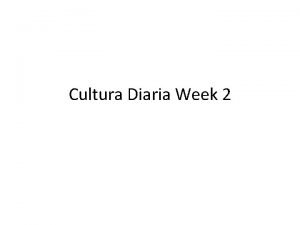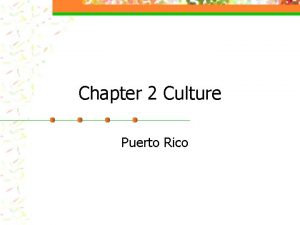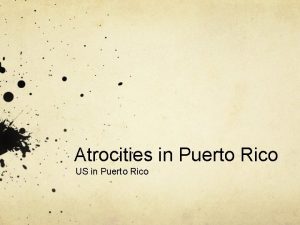Inter American University of Puerto Rico Guayama Campus















































































- Slides: 79

Inter American University of Puerto Rico Guayama Campus Title V Cooperative Project Count and Non-Count Nouns Prof. Marisol Piazza Aguirre

Instructions Use the following buttons to navigate through this module: Use this button to move to the next slide. Use this button to move to the previous slide. Use this button to move to the last viewed slide. Use this button to view the answer to the exercise.

Purpose This module proposes to expand the basic teaching-learning activities of English included in the Title V Cooperative Project: “Improving Academic Outcomes Through a Teaching-Based Consortium Program for the Core Curriculum”. The project is integrated by the Pontifical Catholic University of Puerto Rico in Ponce from where it is directed, the Arecibo, Mayagüez and Guayama Campuses, the School of Plastic Arts of Puerto Rico and Inter American University of Puerto Rico, Guayama Campus.

Introduction

Objectives General Objective: Throughout the study of this module, the student will develop confidence and demonstrate knowledge using Count and Non-Count Nouns in oral and written form according to the rules presented. Specific Objectives: At the end of the module, the student will: recognize Count and Non-Count Nouns. classify nouns as Count or Non-Count. use Count and Non-Count Nouns in sentences.

Pre-Test Instructions: Select the best answer to complete each sentence. ___ 1. Can you please lend me _____ dollars? (A) a little (B) no (C) a few (D) any (E) much ___ 2. Do not feed _____ of the animals at the zoo. (A) some (B) any (C) many (D) no (E) a few

Pre-Test ___ 3. There are _____ houses for sale in the new housing project. (A) many (B) much (C) a little (D) a (E) an ___ 4. There is _____ milk left. I have to go to the supermarket. (A) an (B) many (C) enough (D) a few (E) a little

Pre-Test ____ 5. Is there ____ crime in the metropolitan area? (A) many (B) a few (C) several (D) much (E) enough ____ 6. During the months of August and September there is much ____ in Puerto Rico. (A) water (B) rain (C) oil (D) snow (E) fog

Pre-Test ____ 7. My boss drinks six _____ of coffee every day. (A) jars (B) glasses (C) cups (D) pints (E) bottles ____ 8. Would you like _____ orange juice? (A) some (B) any (C) no (D) many (E) a few

Pre-Test ____ 9. Peter lost his ID card. He is in trouble because he has ____ ID to cash his check at the bank. (A) any (B) a (C) the (D) no (E) one ____10. You shouldn’t eat so much red meat because meat has _____ cholesterol. (A) many (B) a few (C) no (D) much (E) any

Pre-Test ____ 11. A: Are you ready to order , sir ? B: Yes, I would like scrambled eggs with three ____ of bacon and a big glass of grape juice. (A) strips (B) slices (C) pounds (D) packages (E) bags ____ 12. _______ gallons of paint do we need to paint the house? (A) What amount of (B) How much (C) What average of (D) How many (E) What quantity of

Pre-Test ____ 13. Do you have ____ envelope? I need to mail this letter. (A) a (B) two (C) an (D) five (E) the ____ 14. ______ unemployment is there in your town? (A) How many (B) What amount of (C) What quantity of (D) What average of (D) How much

Pre-Test ____ 15. My father eats _____ of oatmeal for breakfast every morning to lower his cholesterol level. (A) a cup (B) a bowl (C) a teaspoon (D) a tablespoon (E) a plate ____ 16. A: What do you usually eat for lunch? B: I usually eat ____ sandwich, ____ potato chips, and ____ glasses of ice tea. (A) a, some, two (B) an, two, some (C) the, much, one (D) two, a little, one (E) many, a lot of, much

Pre-Test ____ 17. Can you please bring me _____ of bread from the bakery store? (A) a slice (B) a strip (C) a pound (D) a roll (E) a piece ____ 18. There are many _______ in my English course. (A) studenties (B) student (C) studentes (D) students (E) student’s

Pre-Test ____ 19. My sister is a vegetarian. She doesn’t eat ____ meat at all. (A) enough (B) a little (C) a lot of (D) much (E) any ____ 20. Where were you all day? I called you many _____, but there was no answer. (A) time (B) times (C) hours (D) minutes (E) seconds

Pre-Test Answer Key 1. 2. 3. 4. 5. 6. 7. 8. 9. 10. C B A E D B C A D D 11. 12. 13. 14. 15. 16. 17. 18. 19. 20. A D C E B A C D E B

Pre-Test Evaluation Total Correct Answers 20 19 18 -12 Test. 11 or Excellent: Go to the Post-Test. Very Good: Review the incorrect answer and go to the Post-Test. Good: Review the incorrect answers, study the rules presented in this module, do the practice exercises and then go to the Post. You Need More Practice: Study the module, less review the rules carefully and do the practice exercises. When you improve your score, you may go to the Post-Test.

Count Nouns: Count Nouns are nouns which can be counted. That means that there can be more than one. Examples: boy dog book restaurant sandwich strawberry…

Count Nouns Use indefinite articles a or an before singular count nouns. Use a before words that start with a consonant sound. Use an before words that start with a vowel sound.

Count Nouns Words that begin with consonant, use a a teacher a hat a flashlight a mountain a rabbit a calculator a donut Words that begin with vowel, use an an artist an onion an umbrella an elephant an iron an elevator an egg

Count Nouns Exception #1: Use an before an h that is silent. Example: an hour ( una hora) Explanation: (h is a consonant, but the h in hour is silent)

Count Nouns Exception #2: Use a before vowel u that is stressed. Example: a university (una universidad) Explanation: (u is a vowel, but the u in university is stressed) (la u en university se pronuncia con fuerza)

Count Nouns Use definite article the for specific things that the listener and speaker know about. Use the before singular count nouns, plural count nouns, and non-count nouns. Use the before words that start with either a consonant or a vowel.

Count and Non-Count Nouns Examples: the teacher (singular count noun) the restaurant (singular count noun) the tiger (singular count noun) the laptops (plural count noun) the apples (plural count noun) the soup the milk (non-count noun)

Count Nouns Use one with singular Count Nouns when you want to specify only one. Examples: child one child (only one) photo store cat foot pineapple one photo (only one) one store one cat one foot one pineapple

Count Nouns can be singular or plural. To form the plural of most count nouns, add –s, -es or –ies. Examples: Singular Plural student brush tray country students brushes trays countries

Count Nouns Some count nouns change from singular to plural in an irregular way. Examples: Singular man woman child tooth foot person Plural men women children teeth feet people

Count Nouns can be counted with numbers. Examples: professor cookie state rabbit one professor two cookies thirteen states ten rabbits

Non-Count Nouns: Non-Count Nouns are nouns which cannot be counted or are difficult to count. Examples: time rice juice weather jewelry pollution butter

Non-Count Nouns Do not use a, an nor one with non-count nouns. A non-count noun does not have a plural form. You can use definite article the with noncount nouns. You use quantifiers to help count non-count nouns.

Non-Count Nouns are classified into five different groups.

Non-Count Nouns Group A: Nouns that have no distinct, separate parts. You look at the whole part. Examples: milk oil water coffee tea yogurt air pork cholesterol paper soup bread meat butter poultry

Non-Count Nouns Group B: Nouns that have parts that are too small or insignificant to count. Examples: rice sugar salt snow sand corn hair grass popcorn

Non-Count Nouns Group C: Nouns that are classes or categories of things. The members of the categories are not the same. Examples: Category (Non-count) Members (count) money ---------------(nickels, dimes, dollars) food-----------------(vegetables, meats, fruits) candy----------------(chocolates, mints, candy bars) furniture---------------(chairs, tables, beds) clothing---------------(sweaters, pants, dresses)

Non-Count Nouns Examples: Category (non-count) Members (count) mail-------------(letters, packages, postcards) fruit-------------(cherries, apples, grapes) makeup----------(lipstick, rouge, eye shadow) homework---------(compositions, exercises, readings) time-------------(seconds, minutes, hours) crime------------(assassinations, hold ups, robberies)

Non-Count Nouns Group D: Nouns that are abstractions. Examples: love (amor) life time truth beauty luck fun help (ayuda) advice knowledge nutrition intelligence employment patience noise information happiness education experience crime music art work (trabajo) health

Non-Count Nouns Group E: Nouns that are Subjects of Study. Examples: history chemistry English zoology grammar geometry Spanish art biology math (mathematics*) geography music… * Even though mathematics ends with s, it is not plural.

Frequently Used Non-Count Nouns Liquids Food Too Small to Count School Subjects milk coffee oil juice soda water lemonade tomato sauce salsa bread ketchup cereal cheese lettuce broccoli ice cream butter mayonnaise cake pasta pizza jelly soup dessert rice oatmeal salt sugar yogurt salsa spaghetti sour cream chicken cauliflower meat fish sugar salt pepper cinnamon rice sand baking powder cereal spaghetti wheat corn math history geography biology chemistry music English Spanish French art Weather Gases Abstract Ideas Others snow rain fog ice oxygen carbon dioxide nitrogen air love beauty happiness luck advice help noise time energy existence stress money mail furniture homework information jewelry garbage toothpaste paper medicine news time work sleep tourism industry agriculture… City Problems traffic pollution crime noise

How to Measure Non-Count Nouns Use quantifiers such as containers, measure words and portions to help you count Non-Count Nouns. Use quantity words such as: much, many, a lot of, a little, a few, some, any, no…to help you have an idea of the amount of a noncount noun.

Examples of How to Measure Non. Count Nouns Examples: coffee bread cereal oil paint soap rain a cup of coffee a slice of bread a bowl of cereal a quart of oil a gallon of paint a bar of soap an inch of rain

Examples of How to Measure Non. Count Nouns By Container By Portion By Measurement By Shape or Whole Piece Other a bottle of water a slice of bread a teaspoon of salt a loaf of bread a piece of rubber a carton of milk a piece of meat a tablespoon of baking soda an ear of corn a piece of furniture a jar of mayonnaise a piece of cake a spoon of sugar a piece of fruit a piece of advice a bag of flour a strip of bacon a scoop of ice cream a head of lettuce a piece of information a can of soda a piece (sheet) of paper a quart of milk a candy bar a piece of art or a work of art

Examples of How to Measure Non. Count Nouns By Container By Portion By Measurement By Shape or Whole Piece a bowl of soup a slice of pizza a pound of salmon a roll of film a cup of coffee a piece of candy a gallon of paint a roll of toilet paper a pint of ice cream a tube of toothpaste a foot of snow a bar of soap an inch of rain A roll of towel paper a glass of juice Other an order of “mofongo”

Important Note about Non-Count Nouns Use singular verbs with Non-Count Nouns. Examples: Correct Incorrect 1. Rice is a main dish in Puerto Rico. 1. Rice are a main dish in Puerto Rico. 2. Ice cream contains many calories. 2. Ice cream contain many calories. Note: Ice cream is a non-count noun, however we see the whole unit as singular. The action verb contain when used with a subject in 3 rd person singular, must be written with –s form. Correct: Ice cream (it) contains many calories.

Count or Non-Count Nouns Some nouns can be either count or noncount nouns. Examples: Non-Count 1. I would like some chicken. 1. There are five chickens in the yard. 2. Did you eat any cake? 2. I bought a cake at the bakery.

Count or Non-Count Nouns In the following cases, the same word can be count or non-count. However, the meaning of each word is different.

Count or Non-Count Nouns Non-Count I spend a lot of time doing exercises. I go to the gym two times a week. I have a lot of experience with computers. I had a lot of interesting experiences on my trip to Venezuela.

Count or Non-Count Nouns In the following cases, there is a small difference in meaning. We see a noncount noun as a whole unit. We see a count noun as something that can be divided into parts.

Count or Non-Count Nouns Non-Count There is a lot of crime in a big city. A lot of crimes are never solved. There is a lot of opportunity to make money in the United States. There a lot of job opportunities in the computer field. Sarah bought a lot of fruit for the meeting. Oranges and grapefruit are fruits that have a lot of Vitamin C. I have much food in my refrigerator. Milk and butter are foods that contain cholesterol. Mike has a lot of trouble with his car. He has many troubles in his life.

Common Quantity Words and Meanings a (count) un, una an (count) un, una (count) muchos, muchas many much (non-count) mucho, mucha a little (non-count) un poco, una poca a few some (count) (count/non-count) unos cuantos, unas cuantas algún, alguna

Common Quantity Words and Meanings several any varios, varias (count) (count/non-count) *Use any with questions and negatives no (count/non-count) *Use no with negatives algún, alguna, algunos, algunas ningún, ninguna, ningunos, ningunas enough (count/non-count) suficiente, suficientes a lot of (count/non-count) mucho, mucha, muchos, muchas How much…? (non-count) ¿ Cuánto/Cuánta…? *Use How much…? with questions How many…? (count) *Use How many…? with questions ¿Cuántos/Cuántas…?

Quantity Words: Some, Any, A, No Singular Count Plural Count Non-Count Affirmative There is a clock in the There are (some) kitchen. windows in the kitchen. There is (some) rice in the microwave. Negative There isn’t a clock in the kitchen. There aren’t (any) windows in the kitchen. There isn’t (any) rice in the microwave. There is no clock in the kitchen. There are no windows in the kitchen. There is no rice in the microwave. Is there a clock in the kitchen? Are there (any) windows in the kitchen? Is there (any) rice in the microwave? Question

Quantity Words: A lot of, Much, Many Count (plural) Affirmative Mother baked many cookies. Non-Count Mother baked a lot of bread. Mother baked a lot of cookies. Negative Question Mother did not bake many cookies. Mother did not bake much bread. Mother did not bake a lot of cookies. Mother did not bake a lot of bread. Did mother bake many cookies? Did mother bake a lot of cookies? How many cookies did mother bake? Did mother bake much bread? Did mother bake a lot of bread? How much bread did mother bake?

Quantity Words: A few, A little Count (plural) Non-Count Affirmative I spend a few dollars every day. Mike eats a few strawberries every morning. I spend a little money every day. Mike puts a little sugar in his coffee. Negative I do not spend a few dollars every day. Mike doesn’t eat a few strawberries every morning. I do not spend a little money every day. Mike doesn’t put a little sugar in his coffee. Question Do you spend a few dollars every day? Does Mike eat a few strawberries every morning? Do you spend a little money every day? Does Mike put a little sugar in his coffee?

Quantity Words: Several, Enough, A lot of Count (plural) Affirmative Negative Question Non-Count There are several pens on the desk. Helen has enough copies for all the students. I receive a lot of e-mails daily. Carlos has enough experience with computers. There aren’t several pens on the desk. Helen doesn’t have enough copies for all the students. I don’t receive a lot of e-mails daily. Carlos doesn’t have enough experience with computers. Are there several pens on the desk? Does Helen have enough copies for all the students? Do you receive a lot of e-mails daily? Does Carlos have enough experience with computers? Do you (ustedes) have a lot of work to do in the English course? We have a lot of work to do in the English course. We don’t have a lot of work to do in the English course.

Practice Exercise Instructions: Select the best answer to complete each sentence. ____ 1. _____ is an example of a Count Noun. (A) pollution (B) jewelry (C) paper (D) people (E) hair ____ 2. _____ is an example of a Non-Count Noun. (A) soap (B) restaurants (C) rabbits (D) children (E) chairs

Practice Exercise ____ 3. I don’t have _____ money to travel next summer. (A) many (B) enough (C) several (D) a few (E) some ____ 4. _____ information did you find about Chinese traditions on the Internet? (A) How many (B) How few (C) How much (D) How little (E) What quantity

Practice Exercise ____ 5. Usually around lunch time, there is _____ traffic in the city. (A) a lot (B) several (C) many (D) much (E) enough ____ 6. I always eat four _____ of pizza when I go to Pizza Hut. (A) plates (B) inches (C) slices (D) strips (E) boxes

Practice Exercise ____ 7. Rice ____ a main dish in Asia and Latin America. (A) is (B) are (C) be (D) was (E) were ____ 8. “Pastas” _____ many calories. Eating “pastas” frequently can make you gain extra weight. (A) contains (B) containes (C) contain’s (D) containies (E) contain

Practice Exercise ____ 9. _______ cartridges of ink do you buy for your printer a year? (A) What amount of (B) What quantity of (C) How many (D) What average of (E) How much ___10. My brother had _____ difficulties finding a job, but he finally found one. (A) many (B) a (C) five (D) much (E) a little

Practice Exercise ____ 11. My baby drinks eight ____ of milk every time I feed him. (A) bottles (B) liters (C) quarts (D) pints (E) ounces ____ 12. Can I have _____ sheets of paper. (A) a little (B) a (C) no (D) several (E) much

Practice Exercise ____ 13. Be careful! There is ____ water on the floor. (A) many (B) some (C) a few (D) no (E) any ___ 14. _____ has been a powerful force in history. Many _____ are practiced in the United States. (A) Religions, religion (B) Religions, religions (C) Religion, religions (D) Religion, religion (E) Religion, religion’s

Practice Exercise ____ 15. The children ate so ____ cake that they started to feel sick. (A) much (B) many (C) enough (D) a little (E) a lot of ___ 16. Are there ____ cats around your neighborhood? (A) any (B) a little (C) much (D) no (E) enough

Practice Exercise ____ 17. I need four _____ to make the beef stew. (A) noodles (B) salt (C) beef meat (D) potatoes (E) tomato sauce ____ 18. The students have ____ time left to finish the exam. The class has ended. (A) several (B) a (C) no (D) any (E) many

Practice Exercise ____ 19. A: Excuse me, Sir. Is there ____ elevator in this building? B: Yes, there is only one elevator. (A) the (B) an (C) a (D) two (E) many ____ 20. How much does a _____ of Bounty towel paper cost at your local supermarket? (A) rollies (B) roll (C) rolls (D) bags (E) rolles

Practice Exercise Answer Key 1. D 2. A 3. B 4. C 5. D 6. C 7. A 8. E 9. C 10. A 11. 12. 13. 14. 15. 16. 17. 18. 19. 20. E D B C A A D C B B

Practice Exercise Evaluation Total Correct Answers: 20 Excellent: Go to the Post Test. 19 Very Good: Review the incorrect answer and go to the Post Test. 18 -12 Good: Review the incorrect answers, consult the module again and then go to the Post Test. 11 or less You Need More Practice: Study the module, review the rules carefully and do the practice exercises again. When you understand the rules and improve your score, you may go to the Post Test.

Post Test Instructions: Select the best answer to complete each sentence. ___ 1. Can you please lend me _____ dollars? (A) a little (B) no (C) a few (D) any (E) much ___ 2. Do not feed _____ of the animals at the zoo. (A) some (B) any (C) many (D) no (E) a few

Post Test ___ 3. There are _____ houses for sale in the new housing project. (A) many (B) much (C) a little (D) a (E) an ___ 4. There is _____ milk left. I have to go to the supermarket. (A) an (B) many (C) enough (D) a few (E) a little

Post Test ____ 5. Is there ____ crime in the metropolitan area? (A) many (B) a few (C) several (D) much (E) enough ____ 6. During the months of August and September there is much ____ in Puerto Rico. (A) water (B) rain (C) oil (D) snow (E) fog

Post Test ____ 7. My boss drinks six _____ of coffee every day. (A) jars (B) glasses (C) cups (D) pints (E) bottles ____ 8. Would you like _____ orange juice? (A) some (B) any (C) no (D) many (E) a few

Post Test ____ 9. Peter lost his ID card. He is in trouble because he has ____ ID to cash his check at the bank. (A) any (B) a (C) the (D) no (E) one ____10. You shouldn’t eat so much red meat because meat has _____ cholesterol. (A) many (B) a few (C) no (D) much (E) any

Post Test ____ 11. A: Are you ready to order , sir ? B: Yes, I would like scrambled eggs with three ____ of bacon and a big glass of grape juice. (A) strips (B) slices (C) pounds (D) packages (E) bags ____ 12. _______ gallons of paint do we need to paint the house? (A) What amount of (B) How much (C) What average of (D) How many (E) What quantity of

Post Test ____ 13. Do you have ____ envelope? I need to mail this letter. (A) a (B) two (C) an (D) five (E) the ____ 14. ______ unemployment is there in your town? (A) How many (B) What amount of (C) What quantity of (D) What average of (D) How much

Post Test ____ 15. My father eats _____ of oatmeal for breakfast every morning to lower his cholesterol level. (A) a cup (B) a bowl (C) a teaspoon (D) a tablespoon (E) a plate ____ 16. A: What do you usually eat for lunch? B: I usually eat ____ sandwich, ____ potato chips, and ____ glasses of ice tea. (A) a, some, two (B) an, two, some (C) the, much, one (D) two, a little, one (E) many, a lot of, much

Post Test ____ 17. Can you please bring me _____ of bread from the bakery store? (A) a slice (B) a strip (C) a pound (D) a roll (E) a piece ____ 18. There are many _______ in my English course. (A) studenties (B) student (C) studentes (D) students (E) student’s

Post Test ____ 19. My sister is a vegetarian. She doesn’t eat ____ meat at all. (A) enough (B) a little (C) a lot of (D) much (E) any ____ 20. Where were you all day? I called you many _____, but there was no answer. (A) time (B) times (C) hours (D) minutes (E) seconds

Post Test Answer Key 1. 2. 3. 4. 5. 6. 7. 8. 9. 10. C B A E D B C A D D 11. 12. 13. 14. 15. 16. 17. 18. 19. 20. A D C E B A C D E B

Post Test Evaluation Total Correct Answers: 20 Excellent: Congratulations! You have successfully completed this module. You may work with a different module if necessary. 19 Very Good: Review the incorrect answer. You may work with a different module if necessary. 18 -12 Good: Review the incorrect answers, review the areas of difficulty and take the Post Test again. 11 or less You Need More Practice: I recommend that you review the complete module and take the Post Test again.

Letter to the Student Congratulations ! You have completed the module on Count and Non-Count Nouns. If you really understand all of the rules and examples presented, you can work with a different module depending on your needs. However, if you still have some questions concerning the rules, I advise you to review this module again or visit the Language Laboratory, Room B-6 and ask for help before studying a different module. Remember you learn by practicing, therefore use the Count and Non-Count Nouns in your daily conversations and written work.
 Fiestas patronales de puerto rico calendario
Fiestas patronales de puerto rico calendario Dos mundos capitulo 4
Dos mundos capitulo 4 El escudo de puerto rico
El escudo de puerto rico Reciclaje de papel en puerto rico
Reciclaje de papel en puerto rico Osha 300 puerto rico
Osha 300 puerto rico Puerto rico webquest
Puerto rico webquest Mapa politico de puerto rico
Mapa politico de puerto rico Mapa politico de puerto rico
Mapa politico de puerto rico What are 5 interesting facts about puerto rico?
What are 5 interesting facts about puerto rico? Los tíos de ellos regresan de puerto rico el sábado.
Los tíos de ellos regresan de puerto rico el sábado. Cuento de juan bobo y el caldero
Cuento de juan bobo y el caldero Villa sin miedo
Villa sin miedo Puerto rico language
Puerto rico language Alexandra cardona puerto rico
Alexandra cardona puerto rico Ahm puerto rico
Ahm puerto rico Elizabeth torres rodriguez puerto rico
Elizabeth torres rodriguez puerto rico Recycling puerto rico
Recycling puerto rico Redsismica puerto rico
Redsismica puerto rico Puerto rico capital
Puerto rico capital Como se formó puerto rico geologicamente
Como se formó puerto rico geologicamente Trombas marinas en puerto rico
Trombas marinas en puerto rico Ptcb exam puerto rico
Ptcb exam puerto rico Lidar puerto rico
Lidar puerto rico 3 adjetivo de familia
3 adjetivo de familia Educacion continua abogados puerto rico
Educacion continua abogados puerto rico Kyokushin karate puerto rico
Kyokushin karate puerto rico Guam and puerto rico
Guam and puerto rico Gerundio de puerto rico
Gerundio de puerto rico Gerundio de puerto rico
Gerundio de puerto rico Pr.pearsonaccessnext.com
Pr.pearsonaccessnext.com Huracan hortensia en puerto rico
Huracan hortensia en puerto rico Puerto rico patria mia la tierra de mis amores
Puerto rico patria mia la tierra de mis amores Jibaro dress puerto rico
Jibaro dress puerto rico Mi salon hogar
Mi salon hogar Seamount
Seamount Guam and puerto rico
Guam and puerto rico Proyecto 103 puerto rico
Proyecto 103 puerto rico Tabla contributiva 2020 puerto rico
Tabla contributiva 2020 puerto rico Puerto rico patria mia la tierra de mis amores
Puerto rico patria mia la tierra de mis amores El yunque national forest animals
El yunque national forest animals Llanos costaneros de puerto rico
Llanos costaneros de puerto rico Llanos costaneros de puerto rico
Llanos costaneros de puerto rico Pozo séptico prefabricado puerto rico
Pozo séptico prefabricado puerto rico Butinah island
Butinah island Est puerto rico
Est puerto rico Puerto rico
Puerto rico Proper adjective for bahamas
Proper adjective for bahamas Interamerican accreditation cooperation
Interamerican accreditation cooperation Campus web brenau
Campus web brenau Keiser student email
Keiser student email Nau grad college
Nau grad college Fordham university visiting student
Fordham university visiting student Woliso university
Woliso university Campus of university of zenica
Campus of university of zenica Usf sacramento campus
Usf sacramento campus Transilvania university romania
Transilvania university romania Sebelas maret university campus
Sebelas maret university campus Off campus housing gmu
Off campus housing gmu Rit campus map
Rit campus map Ambo university woliso campus
Ambo university woliso campus Kodolányi jános university of applied sciences
Kodolányi jános university of applied sciences Preston university islamabad
Preston university islamabad Meiji university ikuta campus
Meiji university ikuta campus Arden university campus london
Arden university campus london Catholic university of korea songsin campus
Catholic university of korea songsin campus Saint louis university campus map
Saint louis university campus map Intranet.brenau.edu
Intranet.brenau.edu Trent university campus
Trent university campus Prince of songkla university
Prince of songkla university Okayama university tsushima campus
Okayama university tsushima campus Dominican university campus safety
Dominican university campus safety Evenly present elements qualtrics
Evenly present elements qualtrics American university career center
American university career center American nazarene university
American nazarene university American university in cairo history
American university in cairo history American university
American university American university mechanical engineering
American university mechanical engineering American university mechanical engineering
American university mechanical engineering American university sustainability
American university sustainability Cassandra muxen md
Cassandra muxen md
